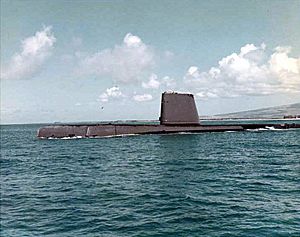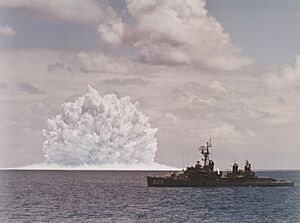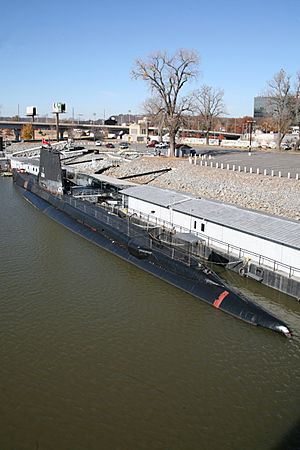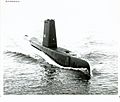USS Razorback facts for kids

Razorback near Hawaii around the 1960s, after getting a big upgrade called GUPPY IIA.
|
|
| History | |
|---|---|
| Builder | Portsmouth Naval Shipyard, Kittery, Maine |
| Laid down | 9 September 1943 |
| Launched | 27 January 1944 |
| Sponsored by | Mrs. H. F. D. Davis |
| Commissioned | 3 April 1944 |
| Decommissioned | August 1952 |
| Recommissioned | 1954 |
| Decommissioned | 30 November 1970 |
| Stricken | 30 November 1970 |
| Fate | Sold to Turkey, 30 November 1970 |
| Name | TCG Muratreis (S-336) |
| Acquired | 30 November 1970 |
| Commissioned | 17 December 1971 |
| Decommissioned | 8 August 2001 |
| Fate |
|
| General characteristics | |
| Class and type | Balao-class diesel-electric submarine |
| Displacement |
|
| Length | 311 ft 6 in (94.95 m) |
| Beam | 27 ft 3 in (8.31 m) |
| Draft | 16 ft 10 in (5.13 m) maximum |
| Propulsion |
|
| Speed |
|
| Range | 11,000 nmi (20,000 km; 13,000 mi) surfaced at 10 knots (19 km/h; 12 mph) |
| Endurance |
|
| Test depth | 400 ft (120 m) |
| Complement | 10 officers, 70–71 enlisted |
| Armament |
|
| General characteristics (Guppy IIA) | |
| Class and type | none |
| Displacement |
|
| Length | 307 ft (94 m) |
| Beam | 27 ft 4 in (8.33 m) |
| Draft | 17 ft (5.2 m) |
| Propulsion |
|
| Speed |
|
| Armament |
|
|
USS Razorback(SS-394)
|
|
| Location | North bank of the Arkansas River at the Arkansas Inland Maritime Museum near I-30 Bridge, North Little Rock, Arkansas |
| Area | less than 1 acre (0.40 ha) |
| Built | 1943 |
| Architect | Portsmouth Naval Shipyard |
| NRHP reference No. | 04001502 |
| Added to NRHP | 1 September 2005 |
The USS Razorback (SS-394) was a special type of submarine called a Balao-class submarine. It was the only ship in the United States Navy named after the fin whale, also known as a razorback whale. This amazing submarine served for 56 years in two different countries, making it one of the longest-serving combat submarines still around.
The Razorback was even in Tokyo Bay when Japan officially surrendered at the end of World War II. Today, it is a museum ship in North Little Rock, Arkansas, at the Arkansas Inland Maritime Museum. The state of Arkansas adopted the submarine in 2004, even though it wasn't named after their famous University of Arkansas Razorbacks mascot.
Contents
Building and Starting Service
The Razorback was built at the Portsmouth Navy Yard in Kittery, Maine. Its construction began on September 9, 1943. It was launched into the water on January 27, 1944. On that day, three other submarines were also launched, making it the only time the U.S. Navy launched four submarines from one shipyard in a single day! The Razorback officially started its service on April 3, 1944, with Lt. Comdr. A.M. Bontier as its first commander.
Service History
World War II Missions
After some initial training near New London, Connecticut, the Razorback headed to Pearl Harbor, Hawaii. Its first war patrol began on August 25, 1944. It sailed east of Luzon to support the landings in Palau.
On its second patrol, starting November 15, the Razorback worked with other submarines. It damaged a large freighter and sank the old 820-ton destroyer Kuretake.
For its third patrol, the Razorback went to the East China Sea. It sank four wooden ships using its deck guns. It also dropped off three Japanese prisoners of war before returning to Pearl Harbor.
The Razorback's fourth patrol involved lifeguard duty. This meant it was ready to rescue pilots who crashed in the ocean. On May 25, it saved a P-51 fighter pilot. On June 5, it rescued four B-29 Superfortress crewmen whose plane was shot down over Kobe, Japan.
Its final war patrol began on July 22 in the Okhotsk Sea. Here, it sank six wooden cargo ships and damaged two others. The submarine also continued its lifeguard duties. On August 31, 1945, the Razorback entered Tokyo Bay with 11 other submarines to be part of the official Japanese surrender ceremony. It then returned to the United States.
After World War II
After the war, the Razorback continued to serve in the Pacific Fleet. It spent time off Japan and China in 1948 and 1949. In August 1952, it was taken out of service for a big upgrade. This upgrade converted it into a GUPPY IIA-type submarine, which made it faster and able to stay underwater longer. It was put back into service in January 1954.
Later Years and Vietnam War
In May 1954, the Razorback moved to San Diego, California. For the next few years, it helped train other Navy ships and planes in anti-submarine warfare. In 1957, it went on a long patrol to the Far East, including watching the Russian port of Petropavlovsk-Kamchatsky.
On May 11, 1962, the Razorback took part in a special test called "SWORDFISH." It was submerged about 2 miles away when a destroyer fired a test weapon. The submarine felt a strong shockwave from the explosion.
The Razorback was often sent to the U.S. 7th Fleet in the 1960s. In 1965, it sailed into the South China Sea and earned its first Vietnam Service Medal for its work during the Vietnam War. It continued to serve in the western Pacific until 1970. Its last mission was from January to August 1970. After returning to the West Coast, it was taken out of U.S. Navy service on November 30, 1970, and transferred to the Turkish Navy.
Awards and Recognition
During its 26 years with the U.S. Navy, the Razorback received many awards. It earned five battle stars for its service in World War II. It also received four campaign stars for its work in the Vietnam War and two Armed Forces Expeditionary Medals.
TCG Muratreis (S-336)
The submarine was renamed TCG Muratreis (S-336) and officially started serving Turkey on December 17, 1971. It was named after a famous Ottoman admiral, Murat Reis. The Muratreis served Turkey for 31 years before being taken out of service on August 8, 2001.
Becoming a Museum Ship
The city of North Little Rock, Arkansas bought the former Muratreis from Turkey on March 25, 2004, for $37,500. Money for the purchase and the cost of towing the submarine came from private donations.
The submarine began its long journey from Turkey on May 5, 2004. It was towed across the Mediterranean Sea and the Atlantic Ocean, arriving in Key West, Florida, on June 13, 2004. It then continued to New Orleans, Louisiana, and was towed up the Mississippi River and the Arkansas River to its final home in North Little Rock.
Getting the submarine up the Arkansas River was tricky because some parts of the river were too shallow. Special barges were used like pontoons to lift the submarine a few feet. This allowed it to clear the river bottom and pass under bridges.
On August 29, 2004, the Razorback finally reached its berth at the Arkansas Inland Maritime Museum in North Little Rock. It officially opened to the public as a museum ship on May 15, 2005.
The Razorback is also the subject of a documentary film called "Greyhound of the Sea: USS Razorback." This film was planned for release in 2016. The museum shares its shoreline with memorials to other submarines, the USS Scorpion (SSN-589) and the USS Snook (SS-279).
Visitors to the Arkansas Inland Maritime Museum can explore the submarine on most Fridays, Saturdays, and Sundays.
In Pop Culture
The USS Razorback is featured in a fictional book called SSN Seadragon The Crucible of Leviathan by J.P. Ronald. In the story, the Razorback, after its GUPPY IIA upgrade, secretly explores beaches off Inchon. It helps land a special agent to gather important information before the famous Inchon landings in 1950.
Awards
The USS Razorback earned many awards during its service:
- China Service Medal
- American Campaign Medal
- Asiatic–Pacific Campaign Medal with five battle stars
- World War II Victory Medal
- Navy Occupation Service Medal
- National Defense Service Medal with one star
- Armed Forces Expeditionary Medal with six stars
- Vietnam Service Medal
- Gallantry Cross (Vietnam)
- Vietnam Campaign Medal
Gallery
See also
 In Spanish: USS Razorback (SS-394) para niños
In Spanish: USS Razorback (SS-394) para niños









